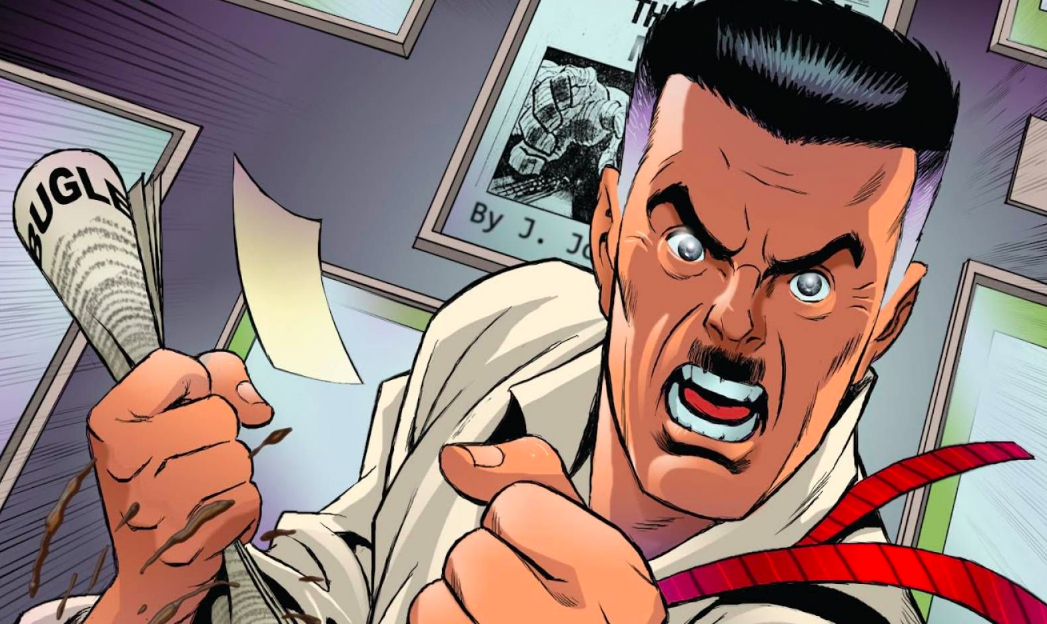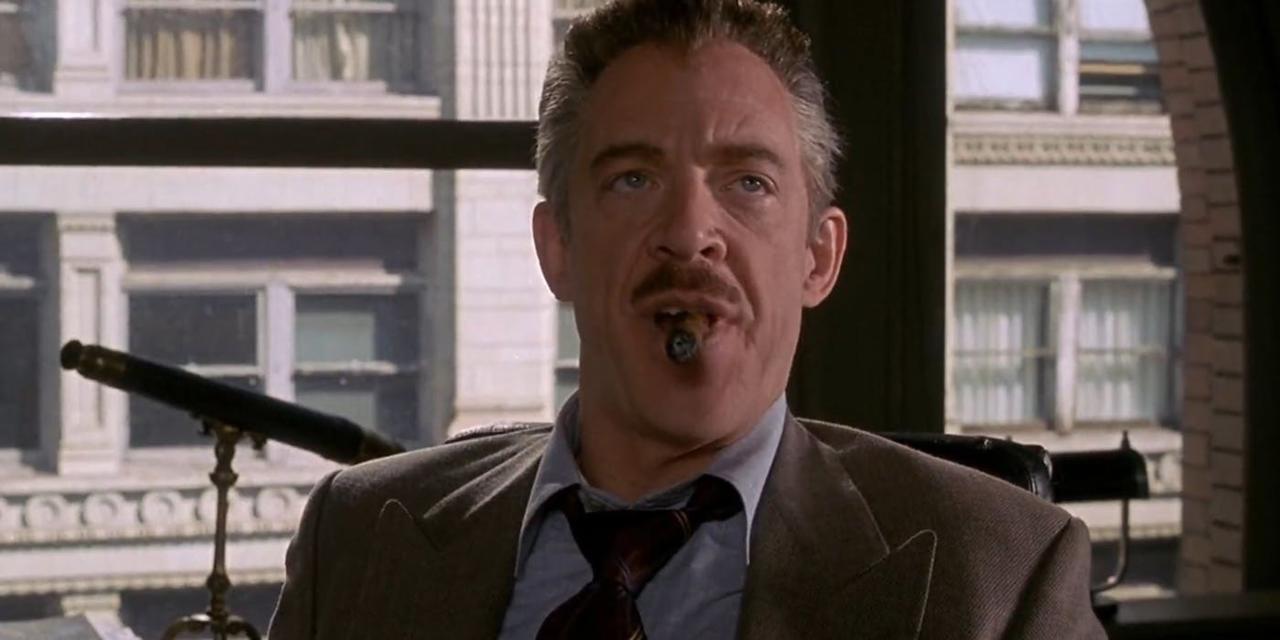If you stuck through the Spider-Man: Far From Home ending credits (and we hope you did--Avengers: Endgame may have broken the tradition of post-credits scenes in the MCU, but Far From Home has brought it back with a vengeance) you will have seen one very familiar and very surprising face--and, if you didn't? Turn back now, because we're about to talk about one of the most surprising returns in superhero movie history. Here's a complete look at the back story behind the scene and character in question, why it was so impactful, and what it could mean going forward.
Major Spider-Man: Far From Home spoilers from here on out!
During the mid-credits scene, we see Peter Parker back home in New York City, happily Spider-Manning around with MJ, until a special broadcast cuts into the Times Square jumbotron. A news outlet called The Daily Bugle has received a special report--a video taken by Mysterio--and the one and only J. Jonah Jameson is here to report.
Oh, yeah. And J. Jonah Jameson is played by none other than J.K. Simmons.
It's a one-two punch of Spider-Man significance that involves some pre-MCU movie knowledge and some seriously weighty comics history. So, with that in mind, let's break it down.
The Bugle, JJJ, And Peter Parker
The Daily Bugle was first introduced all the way back in Fantastic Four #2 by Stan Lee and Jack Kirby in 1962--a little over a year before Peter Parker would be given his own solo ongoing series. The early '60s were a hugely experimental time for superhero stories, and the idea of a proper shared-universe continuity was just beginning to really solidify--something that the existence of the Bugle really helped cement. The Bugle appeared in most early Marvel publications as a bit of background flavor--something to really sell the idea that Marvel's characters all existed in the same version of New York City at the same time.

After its year of relatively background-level existence, the Bugle's offices and the characters within were introduced in Stan Lee and Steve Ditko's The Amazing Spider-Man #1 in 1963. This is where things really started to heat up, giving us our first glimpse of the paper's over-the-top editor, J. Jonah Jameson, and some idea of his zany, antagonistic relationship to put-upon freelance photographer Peter Parker.
Jameson and The Bugle's connection to Peter were instrumental in sparking Spider-Man's initial popularity as a breakout solo hero. In its infancy, Marvel made a name for itself in the superhero genre by publishing stories that bucked the square-jawed conventions put forth by competitors like DC (or National, as it was known at the time). Marvel's heroes were angst-ridden and outcast, products of the post-war era where nuclear anxiety and brewing complications with Vietnam were more relatable than the hard-boiled crime fighting and goofy, ray-gun slinging sci-fi of the '40s and '50s. In those early years, Marvel's characters' ennui usually manifested in a physical way--the X-Men and their mutations that immediately marked them as different, the Fantastic Four's superpowers that looked strange, impossible, or disturbing. But Spider-Man took a different approach--there was nothing physical that denoted Peter as an outsider or a freak, and everything that sparked his angst and confusion was almost entirely mundane.
Sure, he had his Spider-powers, but the things he struggled with were making it through high school as a bullied nerd, hitting deadlines at his thankless job, and trying to survive an endless barrage of complaints by his impossible-to-please boss. You know, the same stuff virtually every human in the world can relate to at one point or another.
JJJ and The Bugle really sold the concept on multiple levels. Not only was Jameson (and by extension, the paper itself) the perfect caricature of a furious editor, the anti-comics panic that pervaded the 1950s, and of Marvel's editorial bullpen itself, he was also given a cartoonish hatred of Spider-Man, making things for Peter even worse as he tried to thread the needle between work, life, and superheroics. It was the perfect blend of high flying escapism and completely relatable existential dread to really hook readers and keep them coming back for more.
In the decades since their introduction, the dynamic between Peter, Jonah, and The Bugle has shifted around countless times--Jonah doesn't always hate Spider-Man (though he usually does), Peter doesn't always work as a photographer, and so on. There have even been a few fleeting moments where Jonah's learned the truth about Peter's identity--though those don't tend to last very long. But, even with a status quo that continues to evolve and change over time, the connection between Spider-Man and The Bugle has crystallized into one of the most universally understood and recognized parts of the character--which, of course, makes it a little odd that it took the MCU this long to cross that particular bridge.
JK Simmons, Spider-Movies, and The MCU
If there's one thing we, as comic movie fans, have absolutely no shortage of, it's live-action Spider-Man movies--and, love them or hate them, Sam Raimi's original trilogy starring Tobey Maguire has cemented itself pretty firmly in the zeitgeist as a watershed moment for superhero movies. But that honor (or disgrace, depending on who you ask) doesn't just sit on Peter's shoulders--the world Raimi and his teams created for these movies informed a whole generation of new Spider-Man fans.

And that absolutely includes JK Simmons and his portrayal of J. Jonah Jameson. Pre-dating the MCU by almost a decade, Simmons was one of the most immediately and fondly recognized elements of the first Spider-Man movie. He looked the part, down to the letter, and sold it with the fist-clenching, cigar-chomping scowl that had defined the character for the last forty-some years of comics. Say what you will about the rest of the cast, from Kirsten Dunst's Mary Jane to James Franco's Harry Osborn, but Simmons was perfect in the role.
In fact, you could argue that he was too perfect. After Raimi's trilogy concluded, the reboot duology starring Andrew Garfield didn't even attempt to bring him in. He was referenced in The Amazing Spider-Man 2, but never actually brought on screen.
For the most part, the MCU has avoided the problem entirely--Tom Holland's Peter Parker is dramatically different from his other live action and comic book incarnations in some key ways. He's not a photographer, he has no interest in reporting or writing, his supporting cast has all been aged down and shifted to mesh with his new status quo rather than his traditional one, and so on. Sure, The Bugle may be one of the things just about everyone, no matter how well they know the comics or the movies, associates with Spider-Man--but the MCU has never really needed it.
At least, until now--and how do you solve the problem of recasting a beloved, well-remembered pop culture icon for a new franchise? Easy: You don't.
JJJ is back in live action, played by JK Simmons, here to ruin Peter's life as per usual--except this time the stakes are dramatically different. For one, Tom Holland's Peter has no relationship with The Bugle or with Jameson at all, making the attack on him both more and less brutal. Make no mistake, having his identity outed is going to royally screw things up, but at least he doesn't have to worry about handling the complete implosion of his day job simultaneously.
On the other hand, this is the first time we've had any experience with The Bugle in the MCU, so we have no idea whether or not this sort of anti-Spider-Man/anti-Superhero rhetoric is part and parcel with Jameson's "brand" or if this is a new thing. Either way, it's perfectly clear that he is more than OK with ruining the life of a high school kid, superhero or otherwise, which is rough, to say the least.
But despite the new context and slight changes to his character, one thing is certain: Now that JJJ is in the mix, nothing in the MCU will ever be the same.
